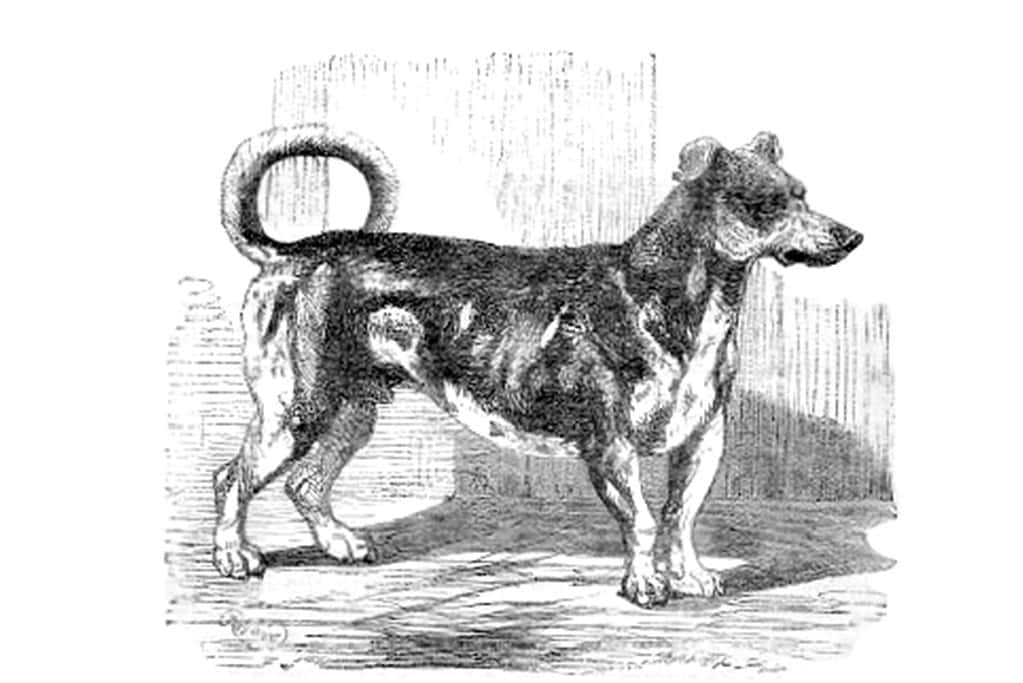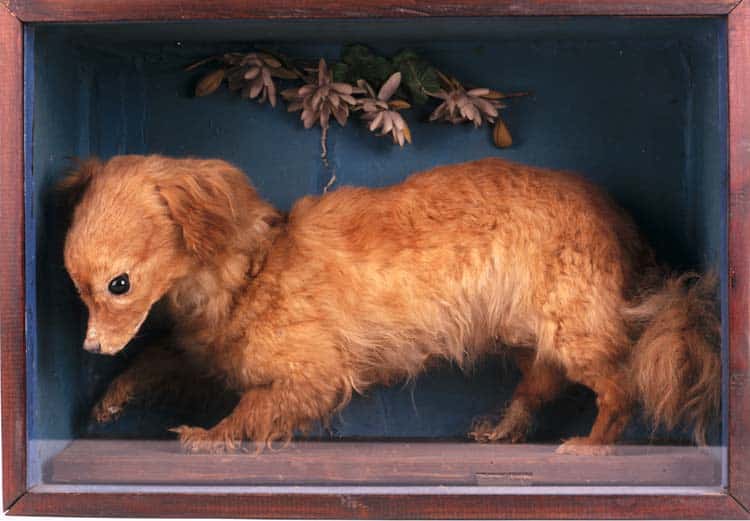
What’s the weirdest, yet useful thing you’ve made your dog do? Whatever it is, there is no way it could outcharm what the turnspit dog (Canis Vertigus) did in the kitchens of 16th-century Britain.
Back in those days, there were no microwave ovens but people still needed to roast meat. So they invented a unique solution.
They employed dogs that were specially bred to run on a wheel. As the wheel rotated, its motion turned the spit placed near the kitchen fireplace, ensuring the meat was well-roasted from all sides (as shown in the image above).
Characterized by a long sturdy body, gray-white fur, and short-crooked legs, these dogs earned multiple monikers, including the kitchen dog, spit dog, vernepator cur, cooking dog, and turnspit dog.
They were so popular that even Shakespeare described them in his play The Comedy of Errors.
However, the turnspit dog breed no longer exists today. Their population began to decline in the 1850s and by the 1900s they went extinct. Here is what made them so popular in the first place, and then ultimately caused their disappearance once they became obsolete.
The origin story of the turnspit dog
The very first mention of the turnspit dog is found in a 16th-century book, Of Englishe Dogges, penned by English physician John Caius. The author wrote that the turnspit dog had the perfect body and stamina to keep the kitchen wheel rotating. It could alone run and power a wheel weighing 30 lbs for hours, resulting in a nicely cooked meal.
Before turnspit dogs came into existence, the iron spit used to cook meat was turned by the “spit boy,” a kitchen servant considered lowly by others. Their task was dangerous and tedious, involving hours of work near the fireplace, leading to excessive sweating, blisters, and constant exposure to nauseating heat.
Nobody knows who bred the first turnspit dog, but their introduction would have brought great relief for the spit boys.
The dogs “so diligently look to their business that no drudge nor scullion can do the feat more cunningly,” Caius notes in his book.
The spit boys could now focus on other less intense works, and soon the animals became a preferred choice for turning the spit. They became so popular that by the year 1750, people could see the dogs working in almost every kitchen in Britain.
The rise of turnspit dogs

At one point in time, they spread throughout the continental United States. Historical records suggest that the family of William Penn, founder of the state of Pennsylvania, requested turnspit dog wheels from England.
During that time, some other Americans also posted ads in Benjamin Franklin’s Pennsylvania Gazette regarding the sale of turnspit dogs.
Kitchen dogs never became as popular in the US as they were in Britain. Their use was limited to a few wealthy people and large hotel kitchens. But they continued to draw the attention of scientists, poets, writers, and the elite.
For instance, apart from Shakespeare, authors such as Robert Chambers (The Book of Days) and Marilynne K. Roach (Presto: Or, The adventures of a turnspit dog) also mentioned the animals in their works.
“His arguments in silly circles run,
Still, round and round, and end where they begun,
So the poor turnspit, as the wheel runs round.
The more he gains, the more he loses ground,” Chambers wrote in his book.
Even renowned biologist Charles Darwin was fascinated with the turnspit dog and considered it a genetically engineered breed.
“Charles Darwin commented on the dogs as an example of genetic engineering. Darwin said, ‘Look at the spit dog. That’s an example of how people can breed animals to suit particular needs.’ ” Lucy Worsley, an author and chief curator at Historic Royal Palaces, told NPR.
However, scientists are still not sure from which breed the turnspit dog originated. Some believe it resulted from the Welsh corgi and some other terrier dogs.
As the popularity of turnspit dogs rose further, people also figured out many other ways in which the animal could be used. For instance, some of the owners began employing them in grain mills, while others used them to churn butter or to run water pumps.
An obsolete dog

Although turnspit dogs were an important member of every kitchen in Britain, their situation was probably worse than the spit boys.
Although the wheel in which they ran in circles was hung at a distance from the fireplace, the dogs had to continuously work in the hot kitchen. On busy days, when the cook forgot to give them water, they would have suffered from intense dehydration.
Some of them even received harsh treatment if they showed signs of tiredness on duty. For example, in his book The Pawprints of History, author Stephen Coren said:
“For dogs that were considered lazy, the cook might put a hot coal into the wheel to make the dog move its feet more quickly.”
Moreover, on Sunday, their owners used them as footwarmers while they prayed in the Church. In the 19th century, many animal activists in Britain and the US began to notice the torture of turnspit dogs and started raising their voices.
“In the 1850s, the founder of the Society for the Prevention of Cruelty to Animals (SPCA) was appalled by the way the turnspit dogs were treated in the hotels of Manhattan. This bad treatment of dogs eventually led to the founding of the SPCA,” William Weaver, an author and food historian, told NPR.
Moreover, by then spit-turning clock jacks had also hit the market. These mechanical tools could be used all the time, without requiring food or water. All these developments eventually freed turnspit dogs from the horrors of hellish kitchens. However, nobody was ready to keep them as regular pets. That was never what they were bred for.
“It became a stigma of poverty to have a turnspit dog, They were ugly little dogs with a quite morose disposition, so nobody wanted to keep them as pets,” Jan Bondeson, writer of the book Amazing Dogs, a Cabinet of Canine Curiosities, told NPR.
The turnspit dogs were now of no use to humans.
So people stopped breeding them and this led to a continuous decline in their population. As a result, in the following 50 years, they became completely extinct.
However, if you still wish to see a turnspit dog, you can visit the Abergavenny Museum in Wales and meet Whiskey, the only remaining stuffed specimen of the kitchen dog.


